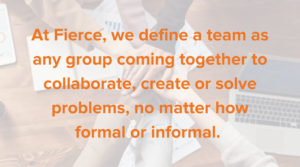We see it all the time. Company’s shelling out tons of cash in the hopes of building more cohesive, satisfied, and productive teams. They engage in short-term team-building exercises and long-term initiatives. But in the end, there’s little to show for their efforts. As it happens, all this effort and money often backfires because it reinforces a divisive work environment.
However, the problem isn’t the effort; it’s more fundamental than that. The problem is with the narrow definition of “teams,” a definition that sees them simply as an organization’s formal divisions (or even sub-divisions). We at Fierce are here to set the record straight by showing you just what kind of trouble you can get yourself into with this perspective. Not to worry, though. We’ve also got a solution. But first, the not-so-good news.
The 4 Harmful Impacts of a Narrow Definition of “Teams”
1. Office Discord and Miscommunication
A team is not merely a division or a silo, but viewing it as such can devastate unity within the office. Imagine this: you decide that in order to strengthen your sales division, you’re going to invite them to quarterly team-building outings–maybe drinks and ax throwing! Sounds pretty awesome, and the sales division will probably love it. Unfortunately, what you win by investing deeply in an individual silo, you lose by driving a deeper wedge between the silos.
Not only does the success of the sales division depend on several support functions and departments–from HR to Marketing to Recruiting to Legal–but each silo could greatly benefit from a closer connection with the others. In fact, fostering this connection (whether through shared events, meetings or something else) can expedite productivity and growth while reducing miscommunication. In a word, it helps create greater synergy across the organization.
2. Non-inclusion.
We see non-inclusion crop up frequently in organizations that rely heavily on top-down ideation and decision-making structures. In these situations, teams simply exist to validate the choices of leaders. This plays out in a number of possible ways.
The first, and most obvious, is outright non-inclusion. This happens when leaders only care to hear support for the direction they have already chosen. Multiple perspectives, alternate directions, and possible roadblocks don’t matter. Even so much as a whiff of a contentious perspective gets shut down immediately. Organizations that struggle with this problem are already in pretty bad shape. Morale is probably already suffering; employees are likely already bitter and disengaged. While all is not lost, a lot of work will need to be done to right the ship. And we mean A LOT.
3. The Illusion of Inclusion
The real danger is with the potential for corrective work to inadvertently create the second, less obvious, situation: non-inclusion masquerading as inclusion. This happens when leaders seek input from their teams, but through their body language, tone of voice, and word choices they communicate that they don’t actually want to hear from them. The leader then walks away believing they’ve done well and that employees are satisfied for having some say in the organization’s direction. Alas, this is so far removed from reality.
Even though this situation is hard to spot on the surface, there are always a few red flags that signal you have a problem. For example, the illusion of inclusion (as we like to call it) is guaranteed to leave employees feeling undervalued and therefore resentful. This state of affairs will stagnate your office culture, halt productivity and stall-out progress. You’ll start to see miscommunication and redundancies everywhere, and the organization’s bigger picture will become muddied. If this sounds at all familiar to you, then some serious reflection is in order.
4. Only the Loudest Get Heard
When things get really bad, employees learn from you that the only way to be heard is to get loud (enter megaphone, stage left). And the more that leaders reinforce this behavior by giving it airtime, the more it communicates to everyone that volume equals progress. And so, the base level volume of your organization gradually creeps up and up and up.
The result is pretty astonishing. On one end of the spectrum, those who are more comfortable voicing their perspectives (who are usually external processors) start feeling like they can actually have a voice, but they have to fight ruthlessly for it. Escalation becomes the norm for them. On the other end of the spectrum, employees who are more reserved about communicating their perspectives (who are usually internal processors) stay silent and feel stifled by leadership and their teammates.
What a Team Really Is … Or at Least Ought to Be

Alright, it’s high time we let the cat out of the back. So what is a better definition of a team anyway? At Fierce, we define a team as any group coming together to collaborate, create or solve problems, no matter how formal or informal. From this perspective, silos don’t function as barriers preventing collaboration.
In practical terms, what if the sales division communicates to the marketing division the key pain points they hear from customers on a daily basis? And what if those pain points conflict with the company’s current marketing focus? Imagine the power your marketing division can leverage when they learn this information. Cross-collaboration makes room for more informed decision-making and more timely and responsive pivots. But cross-collaboration can only begin when you revise what you think a team really is or can be.
Additionally, teams (and we mean the Fierce definition of “teams” here) are where the effective decision-making power actually lies. In fact, our definition flips the conventional script. Major decisions all take a cue from the people with their boots on the ground, from the people getting their hands dirty on a daily basis. This new perspective opens the door for your employees to begin freely expressing their thoughts and emotions and to interrogate their own and others’ views of reality. And they can do this without fear of judgment and therefore without the need to become defensive or aggressive.
In short, the Fierce Team gets to the real issues and provides more nuanced and timely solutions to problems.
Ready to learn more about revolutionizing your teams?




